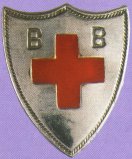
Proficiency Badges - Series 1
(up to 1968)
|
Regulations for these badges changed over the years but generally to obtain these Badges it was necessary for a Boy to have reached a required level and to have attended a course of instruction, varying from a few weeks to two years, with good conduct In some cases a Certificate was issued either as a preliminary stage before the Badge or as a continuation after the Badge. |
||
|
|
||
| The Ambulance Badge / First Aid Badge | ||
|
|
This was the first metal Boys’ Brigade Proficiency Badge, introduced about 1893 and probably based upon the design of a Police Ambulance Badge. Larger than all other subsequent proficiency badges it was worn below these and above the Three Year Anchor, on the right arm. It was changed for a smaller badge around 1923 this was also the first badge to be enamelled. Its title was changed to First Aid Badge in 1956. The Boys’ Brigade course was followed by a three part examination: written; oral; and practical. Subsequent advanced certificates were introduced for higher standards, denoted by coloured felt cloths behind the badge. It was discontinued in 1968.
|
 |
| The Arts and Crafts Badge | ||
 |
This was in introduced in 1927 and discontinued in 1968. It could include Singing, Drawing, Carpentry, Metalwork, Fencing, Photography, etc. The BB had not covered most of these activities until 1927, but The Boys’ Life Brigade (BLB) had started them about 1912 in order to accommodate demands from the Peace Scouts. Much of the detailed syllabus for the BLB awards had originated in Scouting publications.
|
|
| Athletics Badge | ||
 |
This was introduced in 1946 and discontinued in 1968. It was awarded for reaching the required standards in Running, Jumping and Throwing. By 1946 the progress of Physical Activities within the BB was acknowledged. The old Gymnastics badge was renamed Physical Training and the outdoor track and field events were now recognised in this new athletics badge.
|
|
| The Band Badge | ||
 |
Although band badges were issued from the early years of the BB (usually being the cloth Lyre badge worn by the military) the first official BB Band badge was introduced in 1914 and discontinued in 1968. It could well have been the introduction of the Bugle badge in 1909 that provided the incentive for this new badge. It was originally awarded to players of instruments other than Bugles, Pipes or Drums. It was worn in the same position on the armband as were the Drummers’, Pipers’ or Buglers’ Badges. Boys could in fact, gain more that one badge provided they qualified for a further two sessions on a second instrument. Regulations for the badge depended upon each type of instrument.
|
|
| The Buglers’ Badge | ||
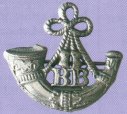 |
This badge was introduced in 1909 and discontinued in 1968. Although this was the first official BB Buglers Badge some Battalions had issued a badge for bugling in the 1880’s. It was awarded after attainment of a satisfactory standard of proficiency on the Bugle.
|
|
| The Campers’ Badge | ||
 |
The BLB had introduced a Pioneers badge in 1912, which was the nearest thing the Brigade had to a Campers Badge. It was actually aimed at the Senior Boy who would be in the Camp Advance Party. Although the first BB camp had been in 1886, it took until the union with the BLB for a campers badge to be introduced. It was introduced in 1927 and discontinued in 1968. It required attendance at Camp and knowledge of Campcraft.
|
|
| The Drummers’ Badge | ||
 |
Like many of the BB proficiency badges BB Boys had worn a drummer’s badge long before the official badge was introduced in 1921. When this badge was finally introduced it complemented the existing band and buglers badges. Qualification was very similar to other band badges. Attendance for two sessions of band work with 90% attendance at a minimum of 25 practices. Drumming Patterns to be successfully played were: Long Roll; Seven Stroke Roll; Eleven Stroke Roll; Four Flams and Four Drags. In 1964, advanced certificates at two levels were introduced until the badge was discontinued in 1968.
|
|
| The Education / Citizenship Badge | ||
 |
Introduced in 1927 as the Education Badge the title changed to Citizenship in 1959/60, with the introduction of the Scripture Knowledge Badge, and it was discontinued in 1968. Certificates in three out of five topics were required for the Education Badge one gained each session. Topics were International Relations; Temperance; Gambling Evil, Scripture Knowledge and Citizenship. With the change in title the topics became Local Government, National Government, Judicial System, Social Responsibility, Church Organisation and Government. An advanced certificate was also introduced.
|
|
| The Expedition Badge | ||
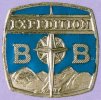 |
This was the last of the nickel series of badges and was introduced in 1964. It was designed to cover the regulations for the Duke of Edinburgh’s Award, within the BB programme. Therefore, a boy going for his D.of E. could gain this badge when the expedition element was completed. To gain this badge boys had to have a knowledge of map reading and Campcraft combined with an Expedition of at least 30 miles with two nights’ camping. This was the second proficiency badge to be enamelled. This badge was discontinued in 1968.
|
|
| The Firemans’ Badge | ||
 |
Introduced in 1927 and discontinued in 1968. This was one of the few badges not to be preceded with a certificate. Boys had to be a minimum of 16 years of age and had to take a course of at least ten lessons with 90% attendance and then pass a practical examination, preferably conducted by a Fire Services Officer. Aspects of the course included: methods of rescue; artificial resuscitation; treatment of burns; burning clothing and use of fire appliances. In 1964 a certificate was introduced involving, where possible, a fire station visit.
|
|
| The Gymnastic / Physical Training Badge | ||
 |
Gymnastics is a long established activity in the BB. Some companies had gymnastic teams as early as the 1890’s. This badge was introduced in 1917, after a long debate on the design the crossed dumbbells were chosen. As part of the award restructuring after the Second World War physical activities were reviewed. In 1946 an Athletics Badge was introduced and the Gymnastics Badge was renamed Physical Training Badge. This badge was discontinued in 1968.
|
|
| The Life Saving Badge | ||
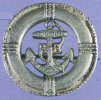 |
The BB became affiliated to the Royal Life Saving Society in 1913 and by 1914 a Life Saving Badge was introduced. On the union with the BLB in 1927 the centre was changes to the double "B" motif to bring it in line with the rest of the proficiency awards. An Intermediate Swimming Certificate was required plus a Royal Life Saving Society test. Until 1959 resuscitation used the Schafer method and then until 1964 the Holger Nielson method. Following this mouth to nose and mouth to mouth methods were used. In 1964 the test became more rigorous; the qualifying age was raised to 15 years of age and an Advanced Certificate introduced, denoted by a red circular felt behind the badge. This badge was discontinued in 1968.
|
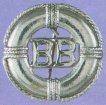 |
| The Pipers’ Badge | ||
 |
This was introduced in 1921. Along with drumming it was one of the last musical proficiency badges to be introduced. As with the other three music badges two sessions of band work with 90% attendance at a minimum of 25 practices were needed. Other requirements included the ability to play correctly a Slow March, Quick March, Strathspey and a Reel of the Pipers own selection. From 1964 two advanced awards were available, involving knowledge of the theory of music and ability to re-tune bass and tenor drones. This badge was discontinued in 1968.
|
|
| The Sergeants’ / NCO’s Proficiency Star | ||
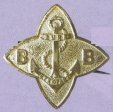 |
This badge was introduced in 1902, and the design was changed to post union crest in 1927. This design was used as a medal prior to this, certainly as early as 1895. Lance Corporals and Corporals could gain the NCO’s certificate, the Star Badge restricted for Sergeants, hence the name. After gaining the NCO’s certificate a Sergeant took a practical examination for the Star. Based on instruction within "The Boys’ Brigade Drill & Rifle Exercises" the exam would be conducted by an Army or T.A. Officer or Sergeant other than the candidates own local Boys’ Brigade Officers. In 1947 the title was changed to NCO’s Star and could be gained and worn by Lance Corporals and Corporals. This badge was discontinued in 1968.
|
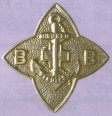 |
| The Seamanship Badge | ||
 |
This was one of two badges introduced in 1946, the other being Athletics, and they both included there names on them. It was run in conjunction with the Signallers, as the Morse Certificate was needed. A substantial oral examination involved knowledge of Nautical Terms, Rules of the Sea, Chart Abbreviation and aspects such as Knot Tying and Rope Splicing were included. A practical test, on the water, to demonstrate the correct practices for getting underway, manning and mooring a boat was also needed. In reality few companies had facilities for such courses and the badge was rarely awarded, making it extremely difficult to find today. It was discontinued in 1968.
|
|
| The Scripture Knowledge Badge | ||
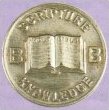 |
Although the BB was built on the twin pillars of faith and drill it may seem strange that the first Scripture Knowledge Badge was not introduced until 1959. The BLB had a Scripture Knowledge Badge but with the union in 1926 no badge was in the list of awards. Scripture Knowledge was included in the syllabus of the Education Badge but this element was withdrawn from the Education Badge when it was renamed Citizenship. Boys were required to gain, in three successive sessions via written tests, three certificates. Three advanced awards could then be gained denoted by a red, blue or white felt cloth worn behind the badge. This badge was discontinued in 1968.
|
|
| The Scouts’ Badge | ||
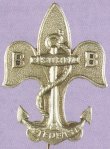 |
Major General R.S.S.
Baden-Powell was a great friend of William Smith and was made an
Honorary Vice-President of the Brigade in 1903. By 1904 he
suggested that some sort of Scout Training would be popular with
the boys and in 1906 Baden-Powell gave the BB the manuscript of
"Scouting for Boys". An experimental Scout Camp was held
in 1907 with a group of 10 boys from BB Companies in Bournemouth
and Poole and 10 boys from public schools. Scouting was originally
intended for use within existing organisations, but by 1908 the
‘Boy Scouts’ had become an organisation in its own right.
Scouting still existed as part of the programme in other
organisations for some thirty years. A BB ‘Scouts badge’ was
introduced in 1909, silver coloured and at first holding no class
but in 1911 a new Gold Scout’s Badge, 1st Class, was introduced,
making the silver a 2nd Class award (gained prior to the gold). In
1917 the gold was discontinued and the silver reverted to first
class status. The test to gain the badge included: Scouting within the BB was discontinued in 1927 on the union with the BLB. Most of the activities being included in the Signallers’ and Wayfarers’ Badges.
|
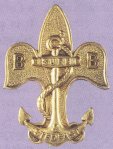 |
| The Signallers’ Badge | ||
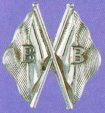 |
Introduced officially in
1911, this was an activity many companies ran from the early years
probably awarding brass army badges for it. Signalling was also
one of the qualifications for the BB Scouts’ Badge. It required
the minimum of two sessions plus the Semaphore and Morse
certificates and various tests: Requirements changed over the years and from 1964 an advanced award existed. This badge was discontinued in 1968.
|
|
| The Swimming Badge | ||
 |
This badge was introduced in 1927.Several changes of style of costume were depicted on this badge over the years, from full costume to trunks. To gain this badge the boys had to have the ability to swim certain distances and to dive. It was discontinued in 1968.
|
|
| The Wayfarers’ Badge | ||
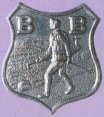 |
This was introduced in 1927 after union with the Boys’ Life Brigade who had a more extensive badge system than the Boys’ Brigade and post union activities had to reflect both organisations. Boys had to be a minimum of 13 years of age and hold the Wayfarer’s Certificate. Tests involved: Knowledge of Knots and their Uses; Use of Compass and Protractors; Working knowledge of a 1" O.S. map with reference to signs and contours and the ability to identify various trees, flowers and birds. Finally the Boy had in one day to either walk a distance equal to his age, cycle 50 miles or climb a mountain to at least 2,000 feet. Several changes of badge style occurred over the years, one being the garments of the walker, knee breeches, long trousers or shorts. This Badge was discontinued in 1968. |
|
If you want to find out everything there is to know about BB Badges and more get the new book Badges of the Brigade - Volume I for more information click HERE
|
All Images Copyright ©
2000 RB Publishing reproduced by kind permission |
|
